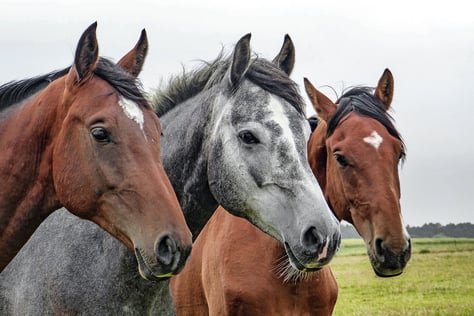 Days are getting shorter, nights are getting colder. Look through any horse product catalog and you’ll see an overwhelming amount of cover-ups for your horse for the coming inclement weather. Quarter sheets, coolers, stable sheets, turnouts. While it’s great to have so many choices, having all those options can be a bit overwhelming. Here are some things to think about before you decide to buy.
Days are getting shorter, nights are getting colder. Look through any horse product catalog and you’ll see an overwhelming amount of cover-ups for your horse for the coming inclement weather. Quarter sheets, coolers, stable sheets, turnouts. While it’s great to have so many choices, having all those options can be a bit overwhelming. Here are some things to think about before you decide to buy.
Consider where you live. If you live in the very cold climates like Minnesota or Montana, you want to look for blankets with a lot of insulation. However, if you live where there are milder winters, like in California, you’ll most likely only need a sheet. Finally, if you live in the Pacific Northwest or other area where winters are mild, but wet, you’ll most likely need something water proof.
Consider where your horse lives. If your horse is in a stall without a paddock, he may be warm enough with a wool blanket. But wool will not keep a horse warm if he gets it wet, so opt for another type of material if you do turnout. The more access your horse has to move around, e.g. a stall and paddock, the more opportunity he has to keep himself warm with movement and not a blanket.
Consider whether your horse is clipped or furry, young or old. Clipped horses need heavier blankets to stay warm in the winter so even if you live in California, you may find you need an insulated blanket. And not all unclipped horses develop thick warm coats in the winter so an additional layer may be needed. Finally, older horses have a harder time staying warm. They may sometimes have arthritis that keeps them from moving around to stay warm as a younger horse may do. If you have a senior horse, think about providing him some extra protection from the cold.
Consider how easy your horse is to blanket. Blankets come with a variety of front closures, including no closure at all. If your horse is the easy-going type, simply slipping it over his head is going to be quick and easy – though you may not have the adjustability of a front buckle blanket. Newer blankets may use hook and loop or hook and eye closures – there’s even a magnetic one. Judge your horse to see what works best. Also consider let straps – they are designed to help keep the blanket from shifting, especially during turnout. But too short straps can cause rubbing while too long straps can catch a rolling or bucking horse’s hoof and cause an accident. It’s safer to keep them a bit longer, but to cross them underneath the horse, ex. Right back end connects to left front end and vice versa.
Consider how your horse is built. Look carefully at the picture of the blanket before you buy. Some blankets have very large neck openings that actually cause the blanket to slide back on your horse’s shoulders. If your horse is narrow, look for European cut blankets which tend to stay a little higher up on the neck. Try your blanket on your horse (over a clean sheet) to make sure it fits.
Consider what you will use the blanket for:
Sheets and blankets – used to keep horses warm when the weather turns cool. Sheets are more lightweight, while blankets are heavier and often have insulation. There are both medium-weight and heavy-weight blankets – buy the one for the coldest part of the winter. Or you can layer blankets. Put on a sheet and then add a medium-weight blanket on top. The air trapped between the layers will help keep him warm.
Dress sheets – used to keep your horse dry and clean when showing.
Coolers and anti-sweat sheets – used to help dry your horse off after bathing or exercise. Coolers used to be large square pieces of wool that attached to the horse’s halter, but these rarely fit well. Look instead for a cooler that is shaped like a blanket. And while wool is still the warmest, it is hard to wash so consider machine-washable fleece instead. Anti-sweat sheets are usually made of cotton and have larger holes in them. They are best used in the warmer months of summer as they don’t offer much in the way of insulation.
Quarter sheets – used to keep the large muscles of your horse’s rear warm when just starting to or right after exercise on cold days. They usually extend from under the saddle to over his rump. Some of them will fasten around your waist, keeping your legs and rump warm at the same time
Take the time to measure your horse for his blanket. Any blanket can keep him warm, but an ill-fitting one can rub and cause sores, especially on his withers. Measuring is best done by two people. Take a cloth tape measure (metal works OK, but doesn’t bend around corners as well) and place one end in the center of your horse’s chest. Have your assistant hold it there while you stretch the tape along the side of your horse at the same height. Bring the tape all the way around the horse’s backside just to the edge of his tail. The number of inches on your tape measure is the size blanket your horse needs. If the measurement is an odd number, order the closest blanket size BIGGER than your number. For example, if your horse is a 79 and your choices are a 78 or an 81, buy the 81. Don’t assume that if he’s the same height as your friend’s horse that they wear the same blanket – comparing two 16.2hh Thoroughbreds who were built about the same, one wore a 78 and one an 81.
While cover-ups aren’t necessary for every horse, it’s important to choose the right one for your horse.



